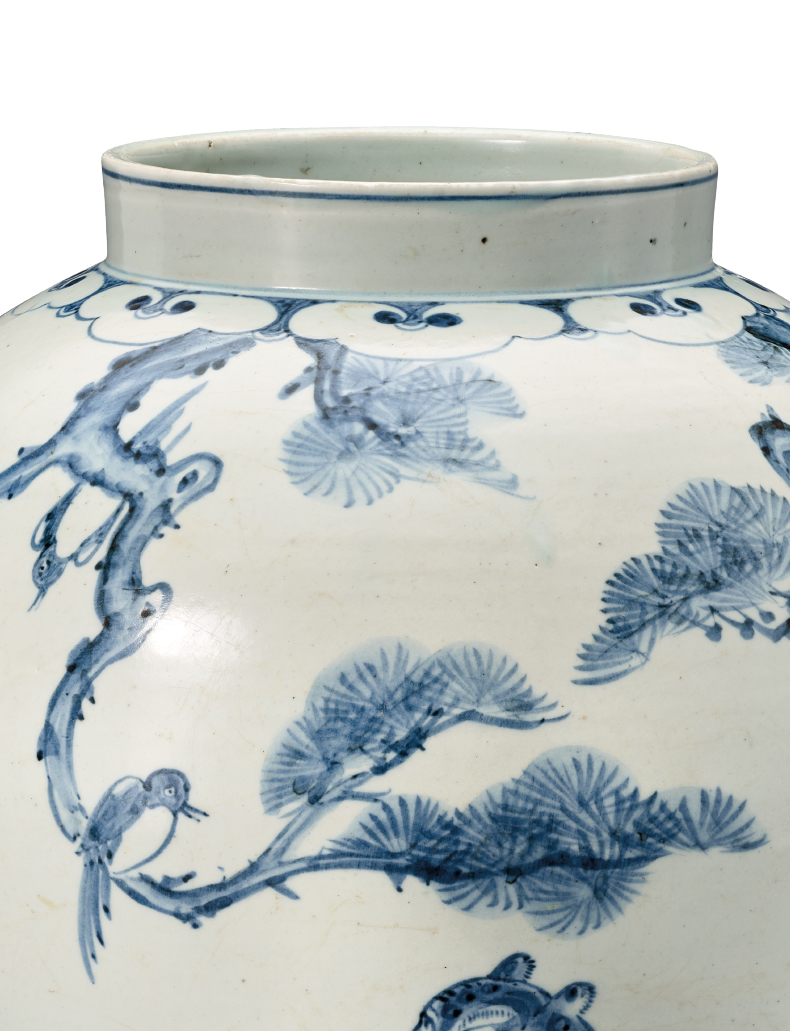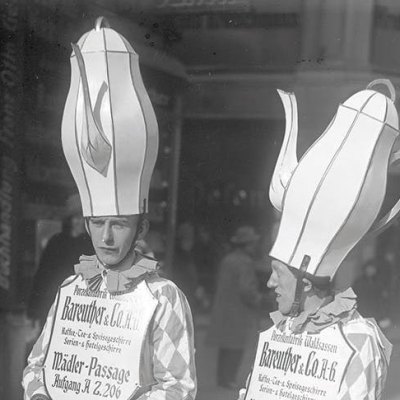From the February 2023 issue of Apollo. Preview and subscribe here.
Robert Mintz of the Asian Art Museum of San Francisco explains how the tension between tigers and magpies in Korean folk tales made its way on to a blue-and-white porcelain vase
We know that this magpie and tiger vase is a decorated vase and we know it is porcelain, so it’s a high-status material with elaborate decoration. Could it have been used as a vase? Probably not, it is a decorative object unto itself for a high-status residence. Does this mean a palace? Maybe. Does this mean the court? Maybe. Does it mean a temple? Maybe. It could be found in any high-status space but clearly it is a prestige object. We know it was likely made during the 18th century, but we don’t know anything more specific than that.
Vase with magpie and tiger design (c. 1700–1800), Korea, Joseon dynasty (1392–1897). Asian Art Museum of San Francisco

From the type of cobalt slip that was used to paint the decoration we know that the vase was likely made during the 18th century. The shade of this cobalt is a type that was being actively imported from China at that period. Korea had discovered its own sources of cobalt for decoration of wares but those produced a darker blue, a kind of blue-purple, which wasn’t preferred by collectors. They preferred this light and delicate blue and during the 18th century there was a flourishing of this shade. This was the popular colour if you had the resources to acquire it.
The reason for its fashionability is hard to pin down, but much of East Asia – Korean society, Japanese society – looked to China and Chinese productions of cobalt blue decoration on white porcelain. The popularity of the colour ebbs and flows over time depending on who is making which kind of blue-decorated white wares but at the root of it all is wanting to look like the original type, that original type being a Chinese type.
The magpie and the tiger as separate iconographies, or separate subjects, have very deep roots in Korean art history and they have serious literati roots. The tiger is an auspicious, protective symbol, a symbol of the deities of the mountains and an image of strength and power, while the magpie is a bringer of good news. When painted alone the tiger is often very serious and stern, and the magpie represents positive ideas and thoughts about the future. When put together they underwent a transformation within the field of folk art. What we see on this vase is not the serious, brooding tiger with a roar that’s heard across a thousand leagues, through the downs and hills. This is a tiger with a smile on his face, smoking a pipe, and this is a playful magpie in the tree, out of the tiger’s reach, so there’s a kind of whimsy that plays out between these two. The idea of the tiger smoking a pipe is a kind of Korean shorthand for ‘once upon a time’ – a time from the ancient past, before people were around, when tigers, being so important and wonderful, used to smoke long pipes. Of course, pipe smoking was a relatively recent occurrence. It came in with the Portuguese traders who brought New World tobacco to East Asia. The long pipe is something that we see in Korea, we see it in China, we see it in Japan, and the tiger with his pipe was adopted as folk imagery.
Vase with magpie and tiger design (c. 1700–1800), Korea, Joseon dynasty (1392–1897). Asian Art Museum of San Francisco

The magpie and the tiger were first depicted together in folk paintings in the 16th century, so by the time this vase was produced it was a very familiar image. There are fairy tales that tie the two symbols together in a way that we can see in cultures around the globe. In this particular fairy tale, the tiger is wandering through the forest and steps into a deep mudpuddle or swamp. The tiger gets stuck and a woodcutter comes along and tries to free the animal. The tiger decides to eat the woodcutter who is upset by the situation. He asks, ‘Why would you eat me?’ The tiger agrees to a trial to see if he should be allowed to eat the man. Slightly unconventionally, the jury is made up of an oak tree who concludes that the tiger should just eat this guy: tigers eat people, that’s what they do. It is a magpie that flies in and says, ‘Oh no, no, what you should do is lure the damn tiger back into that mudpuddle so that you’re safe,’ which duly happens and the woodcutter goes home free. The magpie becomes his saviour, his little charm. Of course, that makes the tiger suspicious of those darn magpies, because magpies look out for humans. Within a fairy-tale structure like that, you’ve got these two opposing forces and humanity is caught between them, either falling victim to the power of the tiger or being preserved by the playful magpie.
This goes some way to explaining the tiger’s facial expression on this vase. This is not a tiger of incredible fierceness, this is a tiger that has a smirk on his face, thinking, ‘Gah, I’m not going to get my lunch after all.’ Of course, if you think about it, this is like painting Cinderella and her one shoe on a vase; everybody would have recognised it and seen that the image alludes to a particular story that we all tell in slightly different ways but which we know is a foundational myth or folk tale.
The way the image is applied to the vase is typical of the brushwork that painting in cobalt slip on a curved surface allows. It is a style that is deeply inspired by, or is an approximation of, the ink painting that had become popular in Korea during the 15th, 16th, 17th centuries. It’s a period in which Korean painters were honing their skills in response to Chinese ink-painting conventions.
The vase itself is unmarked and has a bare foot, offering no suggestion of who the artist might be, which is not surprising for a Korean vase of this period. It is the kind of image that might be in the repertoire of a painter at a particular kiln site. Rather than thinking of the creation of this vase as an artistic commission, think of it more as a line of production, certainly high-quality production. I always think of something like Cartier jewellery as a correlative. Cartier takes the role of the creative artist and a potential customer goes to the known producer to get the high-quality decorative object, rather than commissioning a well-known individual jewellery designer to create a piece. It is probably in this vein that the vase was ordered and purchased.
The artist has not tried to depict the same tiger at different points in the story – each tiger has slightly different markings on his chest and if the artist were trying to connect them he likely would have included a broken pipe or something similar so that the viewer could follow the tiger’s progress. But there is a very definite intention in showing two tigers on the vase. On Korean decorated vases there is a kind of horror vacui, where the artists would not want any empty space. The object is meant to be conceived of and perceived in the round. If there were only the one tiger and magpie it would leave the other side of the vase undecorated. That undecorated space calls for something to fill it, so there’s another tiger. We know that tigers are solitary animals, but occasionally they like to meet up with their friends.
Shape is important in Korean ceramics and many shapes are distinctively Korean. The particular shape of this vase, however, is closely associated with a Chinese prototype shape called the meiping, or a prunus vase, designed to display plum or cherry blossom. It is a high-shouldered, narrow-footed, tapered vase and it is a very common form. Within Korea, however, I think it reaches some of its most elegant proportions. The swelling shoulder of the vase can at times become over swollen and the foot can become too narrow, which makes it look unstable. In other cases the shoulder does not swell far enough and we get an anaemic-seeming vase. Korean vases of this type have a proportion that is just inherently pleasing: stable and really quite elegant.
Vase with magpie and tiger design (c. 1700–1800), Korea, Joseon dynasty (1392–1897). Asian Art Museum of San Francisco

It is not, however, the form of the vase that makes this example stand out – similar vases can be found in the Victoria and Albert Museum and the National Museum of Korea in Seoul – but how the artist has used the surface to draw the viewer into the story. The magpie sits right on the most forward, or the most swollen part of the vase’s shoulder and the tiger, who, in the fairy tale, loses his lunch, is suppressed a little bit by the shoulder of the vase. You can see that the magpie is the winner in this case and I think that the artist allowed that power dynamic to play out across the vase’s surface. This is the work of an artist who is not simply copying an image again and again, but is really thinking about the visual impact of his decorative presentation.
As told to Edward Behrens.
Robert Mintz is deputy director of the Asian Art Museum of San Francisco.
From the February 2023 issue of Apollo. Preview and subscribe here.


